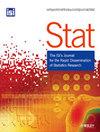用基于回归的个体化治疗规则量化异质性治疗效果:损失函数族和估计误差的界限
IF 0.8
4区 数学
Q3 STATISTICS & PROBABILITY
引用次数: 0
摘要
摘要对治疗反应的异质性是医学界普遍存在的问题。许多研究人员针对这一问题提出了个体化治疗规则方法,即根据个人记录的协变量提出个性化治疗建议。在实践中使用这些方法面临的一个挑战是,它们确定的是治疗规则,而不是量化治疗效果。这可能会造成问题,因为推荐的治疗方法可能会给某些人带来负担,而且对治疗效果的改善微乎其微。为了帮助实践者做出明智的建模选择,我们确定了两个损失函数系列,供个体化治疗规则方法使用。在模型规范正确的假设下,使用其中一个系列的损失函数进行估计,可确保模型的治疗建议可以用风险差异来解释,而另一个系列的损失函数则可确保模型的治疗建议可以用风险比来解释。我们还推导出了模型在风险差异和风险比率估计中的两个误差上限。每个上限都可以通过观察到的数据计算出来,并为实践者提供有关模型在估计治疗效果时的误差的见解。我们通过模拟研究以及 ACTG-175 艾滋病研究的数据来说明我们的贡献。本文章由计算机程序翻译,如有差异,请以英文原文为准。
On quantifying heterogeneous treatment effects with regression‐based individualized treatment rules: Loss function families and bounds on estimation error
SummaryHeterogeneity in response to treatment is a pervasive problem in medicine. Many researchers have proposed individualized treatment rule methods for this problem, which personalize treatment recommendations based on an individual's recorded covariates. A challenge with using these methods in practice is that they determine a treatment rule, rather than quantify treatment benefit. This can be problematic, as a recommended treatment could be burdensome and have negligible improvements in outcome for some individuals. With the aim of helping practitioners make informed modelling choices, we identify two families of loss functions to use with individualized treatment rule methods. Under the assumption of correct model specification, estimation with a loss function from one family ensures that the model's treatment recommendations can be interpreted in terms of the risk difference, while the other family of loss functions ensures that the model's treatment recommendations can be interpreted in terms of the risk ratio. We also derive two upper bounds for a model's error in risk difference and risk ratio estimation. Each upper bound can be calculated using observed data and can provide insight to practitioners regarding model error in estimating treatment effects. We illustrate our contributions with simulation studies as well as with data from the ACTG‐175 AIDS study.
求助全文
通过发布文献求助,成功后即可免费获取论文全文。
去求助
来源期刊

Stat
Decision Sciences-Statistics, Probability and Uncertainty
CiteScore
1.10
自引率
0.00%
发文量
85
期刊介绍:
Stat is an innovative electronic journal for the rapid publication of novel and topical research results, publishing compact articles of the highest quality in all areas of statistical endeavour. Its purpose is to provide a means of rapid sharing of important new theoretical, methodological and applied research. Stat is a joint venture between the International Statistical Institute and Wiley-Blackwell.
Stat is characterised by:
• Speed - a high-quality review process that aims to reach a decision within 20 days of submission.
• Concision - a maximum article length of 10 pages of text, not including references.
• Supporting materials - inclusion of electronic supporting materials including graphs, video, software, data and images.
• Scope - addresses all areas of statistics and interdisciplinary areas.
Stat is a scientific journal for the international community of statisticians and researchers and practitioners in allied quantitative disciplines.
 求助内容:
求助内容: 应助结果提醒方式:
应助结果提醒方式:


